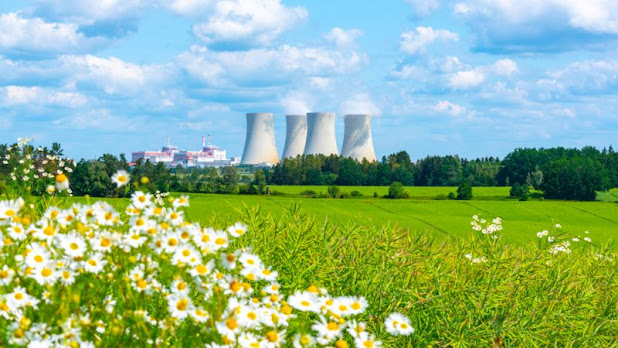STUDENTS : ''' '' GREEN
NUCLEAR GRASP '' '''
WHY IS NUCLEAR SO IMPORTANT FOR REDUCING carbon emissions? The countries that have cleaned up their electricity production the fastest have generally done so with hydroelectric power, nuclear, or a combination of the two.
THE DISTINCT advantage of nuclear is that it requires little land and can reliably produce lots of power regardless of weather, time of day or season. Unlike wind and solar, it can substitute directly for fossil fuels without backup or storage.
The International Energy Agency believes it's so crucial that global nuclear capacity must double by 2050 to reach net-zero emission targets.
On a visit to the site of the Fukushima nuclear plant meltdown in Japan in February, Representative Alexandria Ocasio-Cortez of New York did something refreshing : She discussed radiation exposure and nuclear waste without fanning fear.
The radiation she got from her visit - about two chest X-rays worth - was worth the education she received on the tour, she told her 8.6 million Instagram followers.
She then spoke admiringly of France, which, ''recycles their waste, increasing the efficiency of their systems and reducing the overall amount of radioactive waste to deal with.''
Progressive lawmakers, along with environmental groups like the Sierra Club and Natural Resource Defense Council, have historically been against nuclear power - often focusing on the danger, longevity and storage requirements of radioactive waste.
In America's 2020 presidential campaign, Senator Bernie Sanders said, ''It doesn't make a whole lot of sense to me to add more dangerous waste to this country and to the world when we don't know how to get rid of what we have right now.''
Senator Elizabeth Warren of Massachusetts echoed these concerns and pledged not to build any new nuclear plants if elected president.
So it's no surprise that most of the world believes that nuclear waste poses an enormous and terrifying threat. But after talking to engineers, radiation specialists and waste managers, I've come to see this misunderstanding is holding back from embracing a powerful, clean energy source we need to tackle climate change.
We must stop seeing nuclear waste as a dangerous problem and instead recognize it as a safe byproduct of carbon-free power.
One of our few cultural references to nuclear waste is '' The Simpsons, '' where it appeared as a glowing green liquid stored in leaky oil drums. In reality, nuclear fuel is made up of shiny metal tubes containing small pellets of uranium oxide.
These tubes are gathered into bundles and loaded into the reactor. After five years of making energy, the bundles come out, containing radioactive particles left over from the energy making reactions.
The bundles cool off in a pool of water for another five to 10 years or so. After that, they are placed in steel and concrete containers for storage at the plant. These casks are designed to last 100 years and to withstand nearly anything - hurricanes, severe floods, extreme temperatures, even missile attacks.
TO DATE, there have been no deaths, injuries or serious environmental releases in casks anywhere. And the waste can be transferred to another cask, extending storage one century at a time.
With this kind of nuclear waste, I'm not referring to water containing the radioisotope tritium that nuclear plants regularly release.
Anti-nuclear activist groups like to scaremonger about this, despite the fact that you'd need to drink over a gallon of the treated water being released from Fukushima to get the equivalent of radiation exposure of eating a banana.
BUT WHAT ABOUT the spent nuclear fuel - isn't it radioactive for hundreds of thousands of years? The way radiation works, the waste products that are the most radioactive are the shortest-lived, and those that last a long time are far less dangerous.
About 40 years after the fuel becomes waste, the heat and radioactivity of the pellets have fallen by over 99 percent. After around 500 years, the waste would have to be broken down and inhaled or ingested to cause significant harm.
Compare this to other hazardous industrial materials we store in less secure ways that don't become less toxic over time. Take ammonia : It is highly toxic, corrosive, explosive and prone to leaking.
Hundreds of ammonia-related injuries and even some fatalities have been reported since 2010, and we continue to produce and transport millions of tons of it annually by pipelines, ships and trains for fertilizers and other uses.
The waste should really be a chief selling point for nuclear energy, particularly for those who care about the environment : There's not very much of it, it's easily contained, it becomes safer with time and it can be recycled.
And every cask of spent nuclear fuel represents about 2.2 million tons of carbon, according to one estimate, that weren't emitted into the atmosphere from fossil fuels.
For me, each cask represents hope for a safer, better future.
The Honour and Serving of the Latest Global Operational Research on Carbon-Free Power, continues. The World Students Society thanks author Madison Hilly.
With respectful dedication to Leaders,Scientists, Students, Professors and Teachers of the world. See Ya all prepare for Great Global Elections on The World Students Society - the exclusive ownership of every student in the world : wssciw.blogspot.com and Twitter - !E-WOW! - The Ecosystem 2011 :
Good Night and God Bless
SAM Daily Times - the Voice of the Voiceless

.png)


0 comments:
Post a Comment
Grace A Comment!